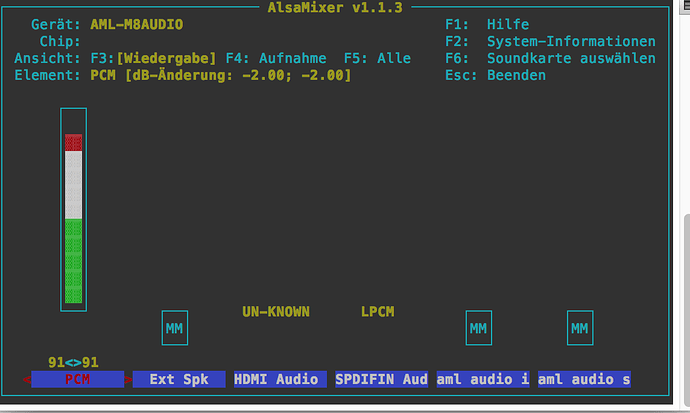OK, so it looks like there is no hardware volume control defined. If you want a volume control you will have to create a softvol. From the way it’s done on vero4k, you could try this in your asound.conf:
pcm.!default {
@args [ CARD ]
@args.CARD { type string }
type softvol
slave.pcm {
type plug
slave {
pcm {
type hw
card $CARD
device 0
}
}
}
control {
name "PCM Playback Volume"
card $CARD
}
}
ctl.!default {
type hw
card 0
}
then see if amixer/alsamixer is showing a volume control.
thx for the instructions. now i have a device in alsamixer where i can regulate the volume. apparently it is not the output device i want to control (at least it does not change the volume of the local output that forked-daapd uses with the config-file above. so, ho do i specify that controlable device in forked-daapd.conf?
cheers
bendsch
i am able to control the volume of the pcm device via mpd/mpc commands now. unfortunately it has no effect on the volume of the output sound (sound is playing but sound-volume stays at the same level no matter how high or low the controler is) …
at the moment the relevant section in forked-daapd shows like that:
#Local audio output
audio {
#Name - used in the speaker list in Remote
nickname = “Computer”
#Type of the output (alsa, pulseaudio, dummy or disabled)
type = “alsa”
#For pulseaudio output, an optional server hostname or IP can be
#specified (e.g. “localhost”). If not set, connection is made via local
#socket.
#server = “”
#Audio PCM device name for local audio output - ALSA only
card = “hw:0”
#Mixer channel to use for volume control - ALSA only
#If not set, PCM will be used if available, otherwise Master.
#mixer = “PCM”
#Mixer device to use for volume control - ALSA only
#If not set, the value for “card” will be used.
#mixer_device = “PCM”
/etc/asound.conf is ecaxtly as you suggested.
what am i missing?
